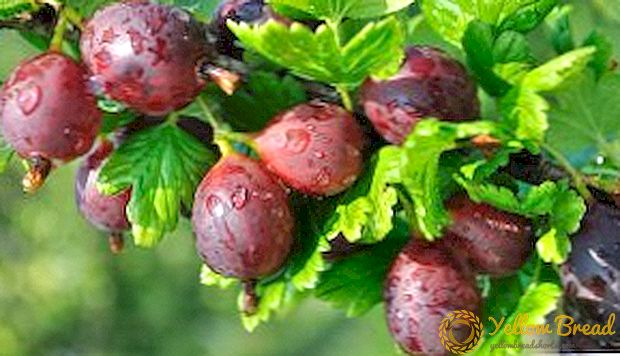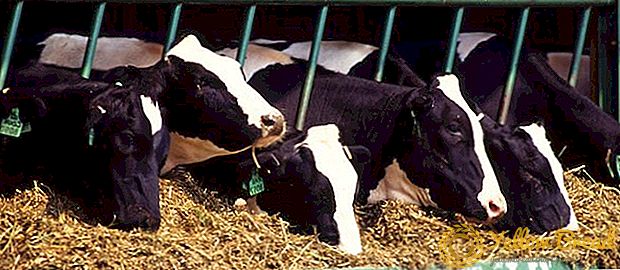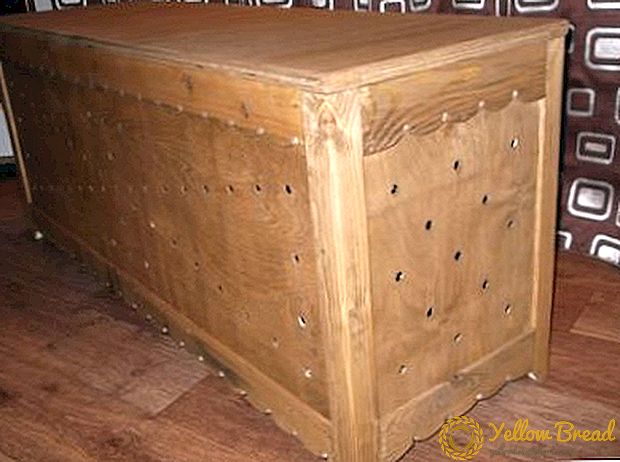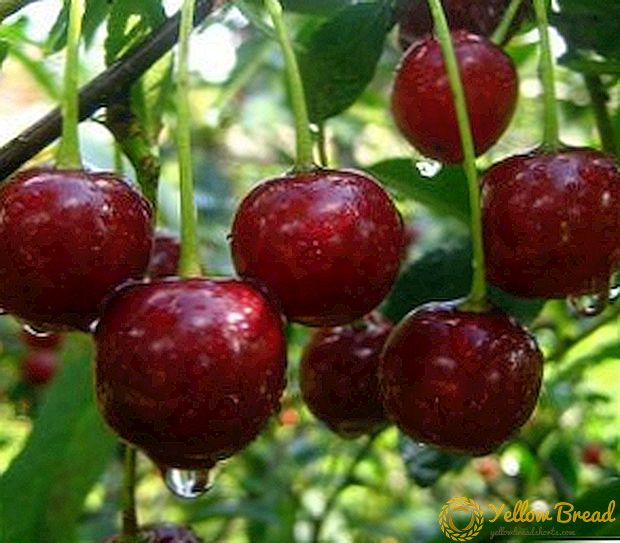 Gooseberry is common in almost all continents, it grows in mountainous areas, in forests and in lowland areas. Gooseberry - a frequent visitor to the gardens, since it is easily propagated, it is well and abundantly fruiting, has a pleasant taste and useful properties.
Gooseberry is common in almost all continents, it grows in mountainous areas, in forests and in lowland areas. Gooseberry - a frequent visitor to the gardens, since it is easily propagated, it is well and abundantly fruiting, has a pleasant taste and useful properties.
- Gooseberry cuttings
- Reproduction green cuttings
- Reproduction by lignified cuttings
- The use of combined cuttings
- How to propagate gooseberry layering
- How to grow a new gooseberry horizontal layering
- Propagation of gooseberries with vertical layers
- Propagation by arcuate shoots (layering)
- How to multiply the gooseberry by dividing the bush
- Is it possible to propagate gooseberry seeds
- Gooseberry reproduction perennial branches
Gooseberry cuttings
Propagation by cuttings is one of the most popular and simple ways to preserve and increase the population of plants in the garden. How to plant gooseberries with a chencer, which of the three ways to choose, we consider in this article.
Reproduction green cuttings
The process of grafting green shoots carried out in the spring, in the first decade of May. The most suitable are the following conditions in the greenhouse: air humidity is 90%, air temperature is +25 ° С, and soil temperature is +18 ° С. Green cuttings (top of young shoots) are taken from a bush not older than four years.
Preparation of gooseberry cuttings for breeding with green cuttings: 
- All lower leaves, except for the top three sheets, need to be cut.
- On the present buds, a longitudinal incision is made with a knife, at the bottom of the shoot - 2-3 incisions along the stem.
- Cuttings for a day put in a bowl of water, then you can dip the stem in a growth stimulator and leave for six hours.
Reproduction by lignified cuttings
This method of reproduction of gooseberry cuttings carried out in the fall. The cuttings are harvested with brown bark, up to 25 cm long, collected in a bundle and planted 15 cm deep into the hole.The cuttings are planted to the top down, because in the spring the upper layer of the soil heats up faster, respectively, the lower roots, which were at the top, also warmed well. At the same time, the kidneys are delayed in development, and the root system develops and strengthens in time. Above planting is covered with a layer of fertile soil, mulch and cover with a dense film.
In the spring, the grown saplings are transferred to the open ground, and two buds are left above the surface of the planting fossa. Cuttings planted at an angle of 10 cm from each other.
The use of combined cuttings
Consider how to propagate gooseberry cuttings in spring or summer, combining seedlings. The combined method is convenient because it is possible to propagate different species and varieties at the same time. Green and lignified cuttings are planted in one hole, make a mini-greenhouse. The best time will be the month of July, but it is possible to plant all spring and summer season.
 Green cuttings in the spring will give fruits, lignified ones strengthen and develop longer. But on reaching a height of 50 cm, they are separated and planted separately. Thus, you kill two birds with one stone, receiving both saplings and a fruiting bush.
Green cuttings in the spring will give fruits, lignified ones strengthen and develop longer. But on reaching a height of 50 cm, they are separated and planted separately. Thus, you kill two birds with one stone, receiving both saplings and a fruiting bush.
How to propagate gooseberry layering
Having tried once this tasty berry, gardeners want to preserve and increase the useful shrubs. Breeding gooseberry is not troublesome, in addition, there is a large selection of breeding methods.
How to grow a new gooseberry horizontal layering
For reproduction by horizontal layers, a furrow about 7 cm deep is prepared, the selected stem bends down (carefully, so as not to break) and fits into the furrow. To prevent the branch from rising arbitrarily, it is fastened with brackets (pieces of wire). From above the layers are covered with fertile soil. Upon reaching the sprouts 10-12 cm, sprinkle a branch with another layer of soil mixed with humus. The second podsypaniye is made on reaching 15 cm, the third - in 20 days. After two weeks, the shoot is separated from the donor bush and transplanted to a permanent place.
Propagation of gooseberries with vertical layers
For the vertical method, layers from bushes older than four years are suitable, while the plant is rejuvenated. The procedure is held in June. All old branches are cut to the root, and the young by two thirds.After pruning, the shrub is covered with fertile soil, when new shoots reach 15 cm in height, the bush is tucked up to half. Then, every 15 cm, the earthing up is repeated.
 In the middle of August you need to feed the bush with urea, do not forget about watering once a week. At the beginning of October, rake up the soil piled when hilling and separate all newly formed shoots together with the roots. A new bush will land on a permanent place in the garden.
In the middle of August you need to feed the bush with urea, do not forget about watering once a week. At the beginning of October, rake up the soil piled when hilling and separate all newly formed shoots together with the roots. A new bush will land on a permanent place in the garden.
Propagation by arcuate shoots (layering)
Gooseberry propagation by arcuate layers is similar to the horizontal method. The difference is that The shoot is strengthened by the arc, and not hiding completely in the ground. Before the plant is filled with soil, superphosphate is applied and watered. Then fall asleep primer so that the arc was above the surface. Twice during the summer season, the shoot is fed with organic matter (infusion of mullein or chicken droppings). Despite the fact that the shoots are less, they are much stronger and begin to bear fruit earlier.
How to multiply the gooseberry by dividing the bush
This method is ideal for breeding valuable varieties. For greater success and to stimulate the growth of new shoots, a year before the intended division, the old stems are pruned at the root.
In the spring, the division is carried out before the swelling of the kidneys, in the fall - until the night frosts. Gooseberry bushes dig up and separate young shoots from old ones. Cut wood with ash to prevent disease. Make sure that the seedling has a developed root system and at least three shoots. Before planting, the soil is fertilized with a complex of superphosphate, potash salt and humus. You can plant immediately on a permanent place.
Is it possible to propagate gooseberry seeds
 Seeds are taken from ripe berries, mixed with sand and left in boxes until the end of autumn. For the winter period, the boxes are buried to a half-meter depth and covered with a layer of soil for 20 cm above, in early spring the seeds are sown in greenhouses, covering with a small layer of peat. When two leaves appear on the seedlings, the seedlings are determined on the beds. In the summer, the shoots weed, watered and loosen the soil around them. In the fall, the grown bushes are planted in the garden.
Seeds are taken from ripe berries, mixed with sand and left in boxes until the end of autumn. For the winter period, the boxes are buried to a half-meter depth and covered with a layer of soil for 20 cm above, in early spring the seeds are sown in greenhouses, covering with a small layer of peat. When two leaves appear on the seedlings, the seedlings are determined on the beds. In the summer, the shoots weed, watered and loosen the soil around them. In the fall, the grown bushes are planted in the garden.
Before growing gooseberries from seeds, keep in mind that this method is good for producing new varieties. Varietal characteristics of the maternal bush with this breeding is not saved.
Gooseberry reproduction perennial branches
 Conducting a rejuvenating pruning bushes, do not throw away cut branches - use them for planting. Make a groove and bury the branch so that only the top of the head is on the surface. Sprinkle the branch with fertile soil. The soil needs to be moistened, and if you pinch the green shoots, the lateral buds will awaken. During growth, shoots need to be fed with Nitrophosphate (20 mg / m²). In the fall, 20-cm-long sprouts are dug out, divided into separate branches with roots and planted in a permanent place.
Conducting a rejuvenating pruning bushes, do not throw away cut branches - use them for planting. Make a groove and bury the branch so that only the top of the head is on the surface. Sprinkle the branch with fertile soil. The soil needs to be moistened, and if you pinch the green shoots, the lateral buds will awaken. During growth, shoots need to be fed with Nitrophosphate (20 mg / m²). In the fall, 20-cm-long sprouts are dug out, divided into separate branches with roots and planted in a permanent place.
This article describes The most convenient methods for breeding a useful shrub: how to propagate by seed, division, cuttings, and how to grow a gooseberry from a sprig. Using some of them, you can multiply the variety you like and even bring out a new one.






